- S.D. Eibar ready for maiden La Liga outing
- SD Eibar stengthen ahead of debut La Liga season
- Can ‘Super Mario’ live up to expectations in Madrid?
- MAN IN THE GROUND – Brentford 0 – 4 Osasuna
- Historic Basque derby welcomes S.D. Eibar to La Liga
- Munich to Madrid, via Brazil – Tony Kroos
- Rakitic in Spanish Switch
- Can Spain find redemption in Rio?
- Viva Espana! A season of redemption for Spanish football
- From the old to the new: who can fill the void in years to come for La Roja?
The spiritual home of Atlético Madrid – El Estadio Metropolitano
- Updated: 17 April, 2012
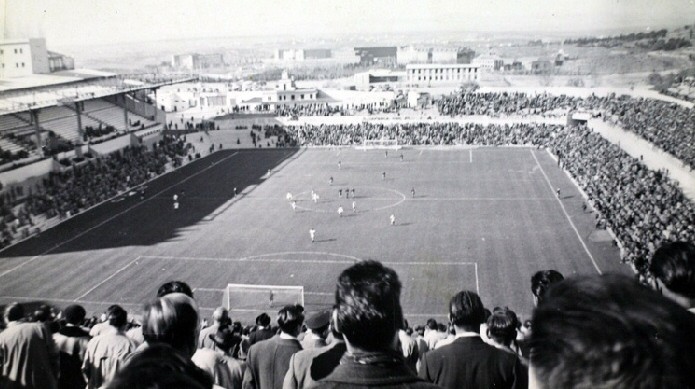
How can I say this politely? Well, it’s like this… Atlético Madrid has played around a bit. There you go, I’ve said it. You see, between its formation in 1903 and moving to their present home in October 1966, Atléti changed venues on ten occasions. However, throughout this period, the club’s one true home was the Estadio Metropolitano.
Founded on 26 April 1903 by a group of Basque students at the Colegio de Ingenieros de Minas, Athletic Club de Madrid was originally an affiliated body of their parent club, Athletic Cub de Bilbao. Early matches were played to the east of Madrid at a very basic ground called the Campo de Vallecas, practically on the site of Rayo Vallecano’s current stadium. In 1913, the club moved to a location in central Madrid on the Calle O’Donnell. This enclosure is often confused with that of Real Madrid’s, which was a hundred metres further west. Here the club remained until May 1923, when it moved to the north west of Madrid and the Metropolitano.
The Estadio Metropolitano was built by the Urbanizadora Metropolitana, the forerunners of today’s Madrid Metro as part of a real estate development close to the city’s University. Architect José María Castell used the site of a natural amphitheatre, and at a cost of 1.5 million pesetas developed what at the time, was the largest and best stadium in the Spanish capital.
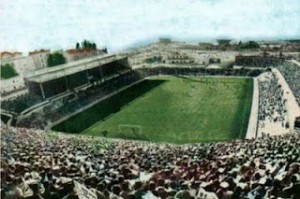 The southern side featured an open area of seating, whilst the eastern end behind the goal had a semi-circular terrace. The northern side was made up of a slim line of wooden bleachers. The west end was left open, but further standing was provided on a cinder athletics track, which ran around the club’s first grass pitch. Officially, the stadium had a capacity of 25,000, but accounts of the stadium’s size vary greatly, in part to the additional standing provided on the athletics track, but also the large open grass banks that stood on either side and above the east terrace. This meant that crowds of 45,000 were not uncommon.
The southern side featured an open area of seating, whilst the eastern end behind the goal had a semi-circular terrace. The northern side was made up of a slim line of wooden bleachers. The west end was left open, but further standing was provided on a cinder athletics track, which ran around the club’s first grass pitch. Officially, the stadium had a capacity of 25,000, but accounts of the stadium’s size vary greatly, in part to the additional standing provided on the athletics track, but also the large open grass banks that stood on either side and above the east terrace. This meant that crowds of 45,000 were not uncommon.
The stadium was inaugurated on 13 May 1923, when a crowd of 25,000 saw Athletic beat Real Sociedad by two goals to one. Whilst the home supporters were happy with the result, they and the local press were less than happy with the new stadium. Transport to the stadium was poor and when you arrived, access into the arena was congested. The Spanish Football Federation was also unhappy at the high cost of admission into the stadium.
Athletic and the Urbanizadora Metropolitana made a commitment to improve transport, access and facilities and by 1925 the stadium had a capacity of 30,000 and improved services. Four years later, 45,000 paid to watch the Spanish National Team inflict the first defeat on England by a continental side. However, Athletic could not agree new terms with the owners and in September 1929 the club left the Metropolitano.
Athletic started the 1929-30 season at Real Madrid’s Charmatin stadium, and also played some home fixtures back in their old stamping ground of the Campo de Vallecas. They eventually returned to the Metropolitano in January of 1930, but the upheaval clearly did not help, and Athletic finished bottom of La Primera and was relegated. During the summer of 1930, the Urbanizadora Metropolitana carried out another upgrade to the stadium, building a covers over the southern and northern sides of the ground, but also converting the athletics track to allow greyhound racing. This didn’t curry any favours with the Spanish Federation, who apparently outlawed the use of the stadium.
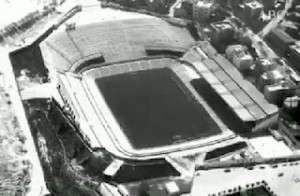 So, Athletic returned to the east of Madrid and the Campo de Vallecas. The pitch at Vallecas was poor and over the next few seasons, the poor surface and disputes with the owners of the Metropolitano, saw the club criss-cross the capital, even playing matches back at Real Madrid’s Chamartin. Athletic won promotion back to La Primera at the end of the 1933-34 season and played home matches during the 34-35 season at the Campo de Vallecas. The following season saw the club return to the Metropolitano, but this didn’t inspire Athletic and they were, relegated. The La Segunda was the last thing on the club’s mind when however, as war broke out on the 15 July 1936.
So, Athletic returned to the east of Madrid and the Campo de Vallecas. The pitch at Vallecas was poor and over the next few seasons, the poor surface and disputes with the owners of the Metropolitano, saw the club criss-cross the capital, even playing matches back at Real Madrid’s Chamartin. Athletic won promotion back to La Primera at the end of the 1933-34 season and played home matches during the 34-35 season at the Campo de Vallecas. The following season saw the club return to the Metropolitano, but this didn’t inspire Athletic and they were, relegated. The La Segunda was the last thing on the club’s mind when however, as war broke out on the 15 July 1936.
The Civil War hit Athletic hard. Only six playing staff returned after the hostilities and the club had debts of over 1 million pesetas. To add to their woes, both the Campo de Vallecas and the Metropolitano had been destroyed during the fighting. Drastic times call for drastic measures and in October 1939 the club merged with the air-force backed Aviación Nacional, to form Athletic-Aviación Club.
Oviedo’s inability to compete in the 39-40 season threw the club a lifeline, and the Federation arranged a play-off between Athletic-Aviación and Osasuna for a place in that season’s first division. Athletic-Aviación won the tie 3-1 and started the 39-40 season back at Real Madrid’s Estadio Chamartin. Under the stewardship of the great Ricardo Zamora, Athletic-Aviación incredibly edged out Sevilla to earn a first ever league title. The club retained the title in 40-41 and during the summer, was forced to change to the Spanish version of their name, becoming Atlético-Aviación. During this period, work was under way on rebuilding the damaged Metropolitano. This included a new main stand, new terracing at the east end and for the first time, a substantial terrace on the north side of the ground. The Metropolitano was re-inaugurated on 21 February 1943 with a 2-1 victory over Real Madrid.
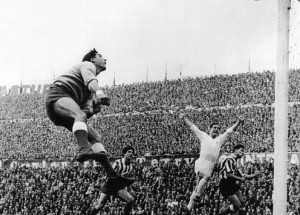 On the back of two further back to back title wins, Atlético finally purchased the Metropolitano on 15 April 1950 and immediately set about improving the facilities. The architect for the work was club president and former player, Javier Barroso. The first phase saw the terracing extended around to the west end and new changing facilities were built beneath.
On the back of two further back to back title wins, Atlético finally purchased the Metropolitano on 15 April 1950 and immediately set about improving the facilities. The architect for the work was club president and former player, Javier Barroso. The first phase saw the terracing extended around to the west end and new changing facilities were built beneath.
Then in the summer of 1954, the club took the audacious decision to excavate the pitch and add another ring of seating where the greyhound/athletics track had stood. This increased the official capacity to 58,000, but despite the refurbishment, the Estadio Metropolitano was soon lagging behind the newer, larger stadiums that Real Madrid and Barcelona built.
In 1961, Atlético purchased large plot of land to the south west of Madrid, on the banks of the Rio Manzanares. Work was slow, and with the Metropolitano sold and the club suffering financially, they moved in with Real Madrid for part of the 1964-65 season. They brokered an agreement to return to the Metropolitano for one final season in 1965-66 and gave the stadium a glorious send-off by winning La Primera. Unfortunately, the new stadium was not ready in time for the start of the 1966-67, so on 18 September 1966, Atlético played their last ever game at the Metropolitano. A 0-1 defeat at the hands of Barcelona brought an end to 43 years of football at this gloriuos old stadium.
_____________________________
To read more on the footballing stadiums of Spain, visit Chris’s excellent site Estadios de fútbol en España
Follow @icentrocampistaOne Comment
You must be logged in to post a comment Login

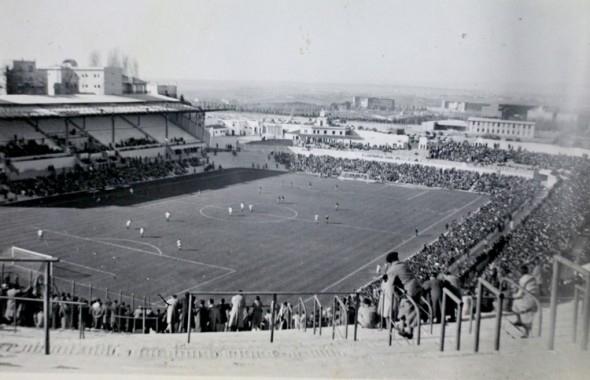

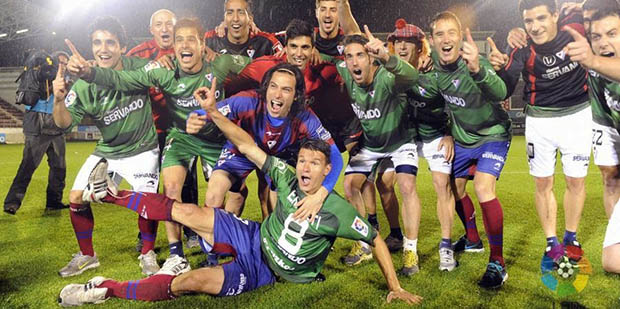
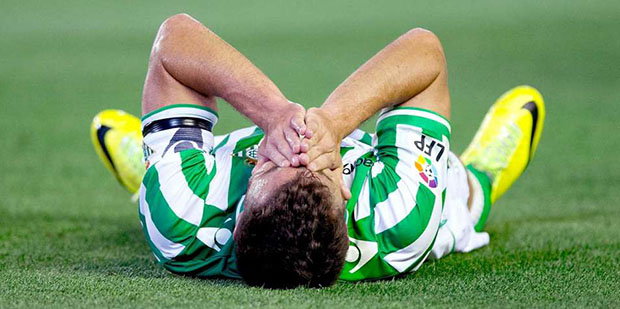

Pingback: The Estadio Metopolitano – Atletico Madrid | elcentrocampista.com – Spanish Football and La Liga News in English « Spain Football News